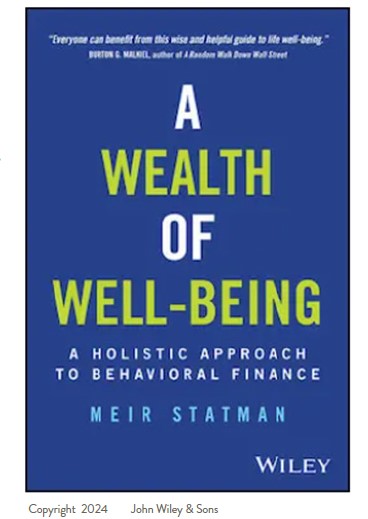
There are plenty of books out there trying to explain why we’re not great with money. Most of them walk you through a checklist of behavioral traps, pointing fingers at our irrational brains and poor decision-making. While those lessons still matter—and it’s still amazing how quickly we forget them when faced with short-term market disturbances—Meir Statman’s, A Wealth of Well-Being, comes at the topic from a different angle. Instead of zeroing in on how we mess up with money, he asks a much bigger question: What are we really hoping to get out of it?
It turns out the answer isn’t just more dollars in the bank or investment account. Statman invites readers to consider the emotional and psychological layers of “well-being” in financial life. – especially money’s contribution to happiness, but also its limits in achieving what we really want: time, freedom, purpose, relationships.
One of the standout insights in the book is a framework for thinking about money and financial products in three ways: 1) Utilitarian – what does it do for us? 2) Expressive – what does it say about us? 3) Emotional – how does it make us feel? If we put a car into that framing, the utilitarian attribute is that it gets us from point A to point B. But it might also reflect our identity (expressive) – we’re thrifty, eco-friendly, or flashy. It might also give us a confidence boost or some amount of joy from the features (emotional).
The same goes for our investments. Usually the utilitarian piece is obvious – we have an objective, be it retirement income or a home purchase. But what about expression? Can investments also reflect how we see the world, like socially responsible investing? And on the emotional front, is our wellbeing tied to a number? Are we stressed if the market goes up and down or are we even-keeled through it all?
Rather than dismissing expression and emotion, Statman acknowledges them as valid. He reminds us that our financial behavior is tangled up in who we are, our past experiences, what and who we care about, and how we see ourselves. There’s no shame in that – just awareness. That awareness can help counter the tendency for our goals to get hijacked by comparing ourselves to others. We may think we’re chasing a number or a net worth, but often we’re actually chasing a feeling: safety, recognition, pride, perceived success. And when we measure our lives against others, the finish line keeps moving.
One particularly thoughtful section unpacks the financial stories we grew up hearing – rags-to-riches tales, overnight success myths, bread lines during the Depression – and how those narratives shape our expectations of ourselves. We start to believe that more is always better, that success has one definition, or that spending should come with guilt. Statman challenges us to consider the tradeoffs in those narratives. More money might also mean missed time with family, frayed relationships, or lost joy. Finding and recognizing that balance point is paramount. We should obsess less about day-to-day fluctuation in the market and squeezing every last drop of return out of our portfolios and be more tuned in to whether our money is serving the life we actually want to lead.
Statman quotes a reader who once wrote to him: “Spend money, but don’t waste it. Don’t make saving a virtue and spending a vice.” That’s really the main theme of the book. It’s about balance – not just between spending and saving, and accumulating and growing, but between utility and meaning, and fear and financial freedom.
In these uncertain times, when everyone’s chasing clarity or control, this book doesn’t give solutions, but it might just help you ask the right questions.